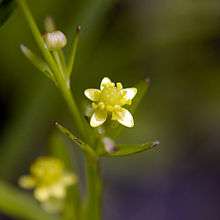Ranunculus abortivus
| Ranunculus abortivus | |
|---|---|
 | |
| Scientific classification | |
| Kingdom: | Plantae |
| (unranked): | Angiosperms |
| (unranked): | Eudicots |
| Order: | Ranunculales |
| Family: | Ranunculaceae |
| Genus: | Ranunculus |
| Species: | R. abortivus |
| Binomial name | |
| Ranunculus abortivus L. | |
Ranunculus abortivus is a species of flowering plant in the buttercup family, Ranunculaceae. Its common names include littleleaf buttercup,[1] small-flower crowfoot,[2] small-flowered buttercup,[3] and kidneyleaf buttercup.[4] It is widespread across much of North America, found in all 10 Canadian Provinces plus Yukon and Northwest Territories, and most of the United States, except Hawaii, Oregon, California, and parts of the Southwest.[1][5]
Ranunculus abortivus produces erect, hairless stems 10 to 60 centimeters (4-24 inches) tall. Each stem can bear up to 50 flowers. The flower has five petals up to 3.5 millimeters (1.2 inches) long.[6]
The plant had a variety of uses among Native American groups. The Cherokee cooked and ate the leaves. They used it medicinally for abscesses and sore throat and as a sedative. The Iroquois used it for snakebite and poisoning, smallpox, and toothache.[7]
References
- 1 2 "Ranunculus abortivus". Natural Resources Conservation Service PLANTS Database. USDA. Retrieved 18 October 2015.
- ↑ Ranunculus abortivus. Germplasm Resources Information Network (GRIN).
- ↑ Ranunculus abortivus. Tropicos.org. Missouri Botanical Garden.
- ↑ Ranunculus abortivus. NatureServe. 2012.
- ↑ Biota of North America Program 2014 county distribution map
- ↑ Ranunculus abortivus. Flora of North America.
- ↑ Ranunculus abortivus. Native American Ethnobotany. University of Michigan, Dearborn.
